Today’s post is a mix and match in multiple ways. There are two recipes that can be eaten together or separately. The roasted broccoli recipe is based on one from Melissa Clark’s lovely cookbook In the Kitchen with a Good Appetite, but it’s backed up by a much linked Ina Garten recipe online. The Romesco sauce–of which there are apparently zillions (literally) of variations–is mostly Deborah Madison’s (yes, from Vegetable Literacy) but with Melissa Clark’s oil and vinegar amounts. But all of that seems fitting for a post on two different aspects of fall vegetables. The broccoli carries with it the hint of cooler weather, while the Romesco sauce uses the last of the late summer produce—roasted red peppers and Roma tomatoes.
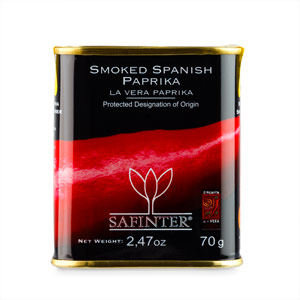 A word about ingredients. Romesco is a Spanish sauce, and both sherry vinegar and smoked paprika appear in the list of ingredients. If you don’t cook a lot of Spanish food, you might think you don’t need to have these in your pantry. For me, the jury is still out on the sherry vinegar. I bought my first bottle in the past year or so and use it occasionally. I’m glad to have it, but it hasn’t (yet) become a staple. Red wine vinegar is probably your best substitute, though the taste isn’t exactly the same. Smoked paprika, on the other hand, has become one of my favorite ingredients ever. Especially if you’re a vegetarian, it’s sometimes hard to get that savory smoky flavor into your food (the kind of flavor you might otherwise get from, say, bacon). Smoked paprika works like a charm. I’ve found that it’s worth it to get the authentic Spanish kind—I like Safinter. (I love Trader Joe’s, but their smoked paprika tastes nothing like real Spanish paprika.) Recently, I was running low, and Whole Foods was temporarily out of stock of the bittersweet kind I like. (It also comes in hot and sweet.) I found myself in a bit of a panic, trying to source it out online. (Thankfully, it came back into stock, and I could relax again.) But really—if you haven’t yet tried it, I’d really recommend it. It’s added new levels of flavor to some of the foods I regularly cook, especially soup (corn chowder, tomato soup, minestrone), and now I can’t imagine my kitchen without it.
A word about ingredients. Romesco is a Spanish sauce, and both sherry vinegar and smoked paprika appear in the list of ingredients. If you don’t cook a lot of Spanish food, you might think you don’t need to have these in your pantry. For me, the jury is still out on the sherry vinegar. I bought my first bottle in the past year or so and use it occasionally. I’m glad to have it, but it hasn’t (yet) become a staple. Red wine vinegar is probably your best substitute, though the taste isn’t exactly the same. Smoked paprika, on the other hand, has become one of my favorite ingredients ever. Especially if you’re a vegetarian, it’s sometimes hard to get that savory smoky flavor into your food (the kind of flavor you might otherwise get from, say, bacon). Smoked paprika works like a charm. I’ve found that it’s worth it to get the authentic Spanish kind—I like Safinter. (I love Trader Joe’s, but their smoked paprika tastes nothing like real Spanish paprika.) Recently, I was running low, and Whole Foods was temporarily out of stock of the bittersweet kind I like. (It also comes in hot and sweet.) I found myself in a bit of a panic, trying to source it out online. (Thankfully, it came back into stock, and I could relax again.) But really—if you haven’t yet tried it, I’d really recommend it. It’s added new levels of flavor to some of the foods I regularly cook, especially soup (corn chowder, tomato soup, minestrone), and now I can’t imagine my kitchen without it.
On to the broccoli! Roasting broccoli is an easy way to add some flavor and crunch to your broccoli. I first learned about the technique from one of Melissa Clark’s “Good Appetite” columns in the New York Times food section. And it was Melissa Clark again who showed me the possibilities for broccoli with Romesco sauce. In her recipe, Clark steams the broccoli lightly, but I was more attracted by the idea of roasting it.
It couldn’t be much easier. You chop the broccoli and spread it on a baking sheet. Drizzle with olive oil and sprinkle with salt and pepper. You can toss with some spices if you’d like–Clark uses cumin seeds, coriander seeds and chili powder. Add some slivers of garlic, if you’d like. Put it in a hot oven and let it roast for 20-30 minutes. Squeeze some lemon juice on, and it’s done–crispy, savory, good enough to convert even a stalwart broccoli skeptic.
In Melissa Clark’s recipe that served as my inspiration, she has you toss the broccoli in the Romesco sauce. But I preferred to keep them separate and to dip the broccoli (and the fingerling potatoes I’d roasted at the same time) in the sauce.
If you want to be efficient in your oven use, you can roast the broccoli and the red peppers and tomatoes for the sauce in the same 400 + oven.
I am not a Romesco sauce expert, but from what I’ve read, the common ingredients are roasted red peppers, tomato, hazelnuts or almonds, olive oil, paprika, sherry vinegar. I mostly followed Deborah Madison’s recipe, including sauteing a piece of bread in olive oil (Melissa Clark has you use breadcrumbs, and since it all goes in a food processor, you end up at the same place.) But I balked at the amount of oil she called for and used Clark’s more modest amounts instead. The sauce was pungent, smoky and delicious. So far, I’ve had it on the broccoli and roasted potatoes, on pasta, on bread from the Hungry Ghost and as a dip. I can also see how a spoonful could add another level of flavor to a soup, stew or sauce. This was a new recipe to me, but I can already see that it will become a regular.
- 1 large or 2 small heads of broccoli
- 2-3 tbsp olive oil
- 1 tsp. Kosher salt (1/2 tsp if regular table salt)
- lemon juice
- more salt and pepper to taste
- optional: slivered garlic, spices (cumin, coriander, chili powder), herbs (like basil), Parmesan cheese
Romesco Sauce
Adapted from Deborah Madison’s Vegetable Literacy
- ½ cup plus 2 Tbsp. olive oil (I used much less than this–see notes below)
- 1 slice country bread
- ½ cup almonds, hazelnuts or a mix, toasted (if using hazelnuts, peel them–the peels will come off easily once they’re toasted.)
- 3 cloves garlic
- 1½ teaspoons New Mexican or other ground red chili powder
- 4 ‘Roma’ tomatoes, fresh, grilled or pan roasted
- 1 Tbsp. chopped parsley
- 1 tsp. fresh thyme leaves, or a few pinches dried
- Sea salt
- 1 tsp. sweet or smoked paprika
- 2 red bell peppers, roasted, peeled and seeded
- ¼ cup sherry vinegar (I used less than this.)
Warm 2 Tbsp. of the olive oil in a small skillet. Add the bread, turn it immediately so that both sides are moistened with oil, then fry until golden and crisp. (I chose mince the garlic up and saute it in the same olive oil as the bread rather than put it into the sauce raw. I then added the oil and the garlic to the food processor, as in the step below.)
Notes: There are lots of ways to roast red peppers. An easy way is to put them on a cookie sheet lined with tin foil in a hot (400 minimum) oven. You can roast them whole, as long as you keep an eye on them and make sure to turn them over while they’re roasting. For this recipe, I followed Madison’s suggestion and cut them in half first, removing the seeds, and placed them cut side down on the cookie sheet. I chose to roast my Roma tomatoes at the same time, just cut in half and placed cut side up on the cookie sheet. I’d say they’ll roast in 30-35 minutes, but it’s best to be around in the kitchen to check them. Once they’re done—you’ll know this because the skin has blackened in spots and may be peeling off— I usually put the peppers in a paper bag inside a mixing bowl. Close the bag and let them sit for a few minutes to cool down. When you return to them, the skins should peel off easily. (I usually put the bag in the bowl because sometimes they’re juicy and the bag will fall apart, so it’s nice to have the peppers and their juices contained already.


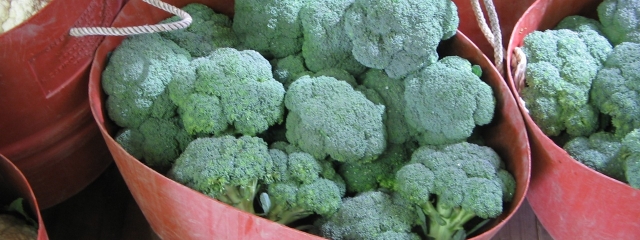
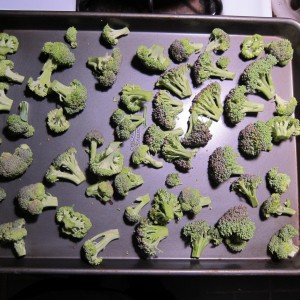
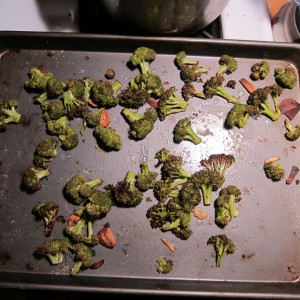
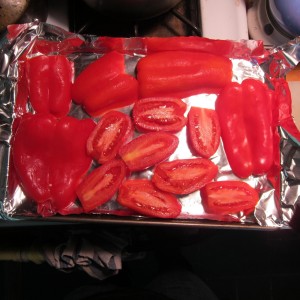
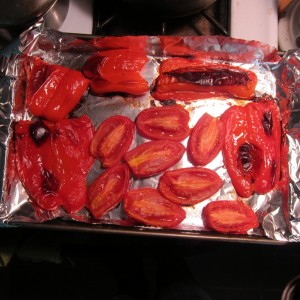

It’s a wonderful recipe. I love it. Thanks for sharing this recipe.
So glad you like it!
Thanks to the writer for sharing this recipe and I will try this